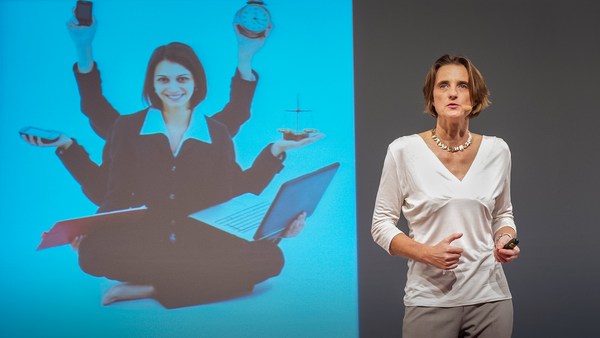When I was growing up, I really liked playing hide-and-seek a lot. One time, though, I thought climbing a tree would lead to a great hiding spot, but I fell and broke my arm. I actually started first grade with a big cast all over my torso. It was taken off six weeks later, but even then, I couldn't extend my elbow, and I had to do physical therapy to flex and extend it, 100 times per day, seven days per week. I barely did it, because I found it boring and painful, and as a result, it took me another six weeks to get better.
Many years later, my mom developed frozen shoulder, which leads to pain and stiffness in the shoulder. The person I believed for half of my life to have superpowers suddenly needed help to get dressed or to cut food. She went each week to physical therapy, but just like me, she barely followed the home treatment, and it took her over five months to feel better.
Both my mom and I required physical therapy, a process of doing a suite of repetitive exercises in order to regain the range of movement lost due to an accident or injury. At first, a physical therapist works with patients, but then it's up to the patients to do their exercises at home. But patients find physical therapy boring, frustrating, confusing and lengthy before seeing results. Sadly, patient noncompliance can be as high as 70 percent. This means the majority of patients don't do their exercises and therefore take a lot longer to get better. All physical therapists agree that special exercises reduce the time needed for recovery, but patients lack the motivation to do them.
So together with three friends, all of us software geeks, we asked ourselves, wouldn't it be interesting if patients could play their way to recovery? We started building MIRA, A P.C. software platform that uses this Kinect device, a motion capture camera, to transform traditional exercises into video games.
My physical therapist has already set up a schedule for my particular therapy. Let's see how this looks. The first game asks me to fly a bee up and down to gather pollen to deposit in beehives, all while avoiding the other bugs. I control the bee by doing elbow extension and flexion, just like when I was seven years old after the cast was taken off.
When designing a game, we speak to physical therapists at first to understand what movement patients need to do. We then make that a video game to give patients simple, motivating objectives to follow. But the software is very customizable, and physical therapists can also create their own exercises. Using the software, my physical therapist recorded herself performing a shoulder abduction, which is one of the movements my mom had to do when she had frozen shoulder. I can follow my therapist's example on the left side of the screen, while on the right, I see myself doing the recommended movement. I feel more engaged and confident, as I'm exercising alongside my therapist with the exercises my therapist thinks are best for me. This basically extends the application for physical therapists to create whatever exercises they think are best.
This is an auction house game for preventing falls, designed to strengthen muscles and improve balance. As a patient, I need to do sit and stand movements, and when I stand up, I bid for the items I want to buy. (Laughter)
In two days, my grandmother will be 82 years old, and there's a 50 percent chance for people over 80 to fall at least once per year, which could lead to a broken hip or even worse. Poor muscle tone and impaired balance are the number one cause of falls, so reversing these problems through targeted exercise will help keep older people like my grandmother safer and independent for longer. When my schedule ends, MIRA briefly shows me how I progressed throughout my session.
I have just shown you three different games for kids, adults and seniors. These can be used with orthopedic or neurologic patients, but we'll soon have options for children with autism, mental health or speech therapy. My physical therapist can go back to my profile and see the data gathered during my sessions. She can see how much I moved, how many points I scored, with what speed I moved my joints, and so on. My physical therapist can use all of this to adapt my treatment.
I'm so pleased this version is now in use in over 10 clinics across Europe and the U.S., and we're working on the home version. We want to enable physical therapists to prescribe this digital treatment and help patients play their way to recovery at home. If my mom or I had a tool like this when we needed physical therapy, then we would have been more successful following the treatment, and perhaps gotten better a lot sooner.
Thank you.
(Applause)
Tom Rielly: So Cosmin, tell me what hardware is this that they're rapidly putting away? What is that made of, and how much does it cost?
Cosmin Milhau: So it's a Microsoft Surface Pro 3 for the demo, but you just need a computer and a Kinect, which is 120 dollars.
TR: Right, and the Kinect is the thing that people use for their Xboxes to do 3D games, right?
CM: Exactly, but you don't need the Xbox, you only need a camera.
TR: Right, so this is less than a $1,000 solution.
CM: Definitely, 400 dollars, you can definitely use it.
TR: So right now, you're doing clinical trials in clinics.
CM: Yes.
TR: And then the hope is to get it so it's a home version and I can do my exercise remotely, and the therapist at the clinic can see how I'm doing and stuff like that.
CM: Exactly.
TR: Cool. Thanks so much. CM: Thank you.
(Applause)





